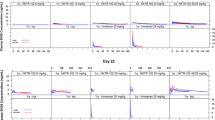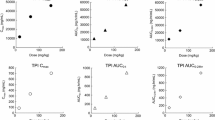Abstract
Purpose
A toxicology and pharmacokinetic study of orally administered (po) IPdR (5-3iodo-2-pyrimidinone-2′deoxyribose, NSC-726188) was performed in Fischer-344 rats using a once daily (qd) × 28 days dosing schedule as proposed for an initial phase I clinical trial of IPdR as a radiosensitizer.
Methods
For the toxicology assessment, 80 male and female rats (10/sex/dosage group) were randomly assigned to groups receiving either 0, 0.2, 1.0 or 2.0 g kg−1day−1 of po IPdR × 28 days and one-half were observed to day 57 (recovery group). Animals were monitored for clinical signs during and following treatment with full necropsy of one-half of each dosage group at day 29 and 57. For the plasma pharmacokinetic assessment, 40 rats (10/sex/dosage group) were randomly assigned to groups receiving either 0.2 or 1.0 g kg−1day−1 of po IPdR × 28 days with multiple blood samplings on days 1 and 28 and single blood sampling on days 8 and 15.
Results
No drug-related deaths occurred. Higher IPdR doses resulted in transient weight loss and transient decreased hemoglobins but had no effect on white cells or platelets. Complete serum chemistry evaluation showed transient mild decreases in total protein, alkaline phosphatase, and serum globulin. Necropsy evaluation at day 29 showed minimal to mild histopathologic changes in bone marrow, lymph nodes and liver; all reversed by day 59. There were no sex-dependent differences in plasma pharmacokinetics of IPdR noted and the absorption and elimination kinetics of IPdR were found to be linear over the dose range studied.
Conclusions
A once-daily dosing schedule of po IPdR for 28 days with doses up to 2.0 g kg−1day−1 appeared to be well tolerated in Fischer-344 rats. Drug-related weight loss and microscopic changes in bone marrow, lymph nodes and liver were observed. These changes were all reversed by day 57. IPdR disposition was linear over the dose range used. However, based on day 28 kinetics it appears that IPdR elimination is enhanced following repeated administration. These toxicology and pharmacokinetic data were used when considering the design of our initial phase I trial of po IPdR as a clinical radiosensitizer.




Similar content being viewed by others
References
Berry SE, Kinsella TJ (2001) Targeting DNA mismatch repair for human tumor radiosensitization. Semin Radiat Oncol 11:300–315
Berry SE, Loh T, Yan T, Kinsella TJ (2003) Role of MutSalpha in the recognition of iododeoxyuridine in DNA. Cancer Res 63:5490–5495
Chang AE, Collins JM, Speth PA, Smith R, Rowland JB, Walton L, Begley MG, Glatstein E, Kinsella TJ (1989) A phase I study of intraarterial iododeoxyuridine in patients with colorectal liver metastases. J Clin Oncol 7:662–668
Chang CN, Doong SL, Cheng YC (1992) Conversion of 5-iodo-2-pyrimidinone-2′-deoxyribose to 5-iodo-deoxyuridine by aldehyde oxidase. Implication in hepatotropic drug design. Biochem Pharmacol 43:2269–2273
Efange SM, Alessi EM, Shih HC, Cheng YC, Bardos TJ (1985) Synthesis and biological activities of 2-pyrimidinone nucleosides. 2. 5-Halo-2-pyrimidinone 2′-deoxyribonucleosides. J Med Chem 28:904–910
Kinsella TJ (1996) An approach to the radiosensitization of human tumors. Cancer J Sci Am:184–193
Kinsella TJ, Collins J, Rowland J, Klecker R Jr, Wright D, Katz D, Steinberg SM, Glastein E (1988) Pharmacology and phase I/II study of continuous intravenous infusions of iododeoxyuridine and hyperfractionated radiotherapy in patients with glioblastoma multiforme. J Clin Oncol 6:871–879
Kinsella TJ, Kunugi KA, Vielhuber KA, McCulloch W, Liu SH, Cheng YC (1994) An in vivo comparison of oral 5-iodo-2′-deoxyuridine and 5-iodo-2-pyrimidinone-2′-deoxyribose toxicity, pharmacokinetics, and DNA incorporation in athymic mouse tissues and the human colon cancer xenograft, HCT-116. Cancer Res 54:2695–700
Kinsella TJ, Kunugi KA, Vielhuber KA, Potter DM, Fitzsimmons ME, Collins JM (1998) Preclinical evaluation of 5-iodo-2-pyrimidinone-2′-deoxyribose as a prodrug for 5-iodo-2′-deoxyuridine-mediated radiosensitization in mouse and human tissues. Clin Cancer Res 4:99–109
Kinsella TJ, Schupp JE, Davis TW, Berry SE, Hwang HS, Warren K, Balis F, Barnett J, Sands H (2000) Preclinical study of the systemic toxicity and pharmacokinetics of 5-iodo-2-pyrimidinone-2′-deoxyribose as a radiosensitizing prodrug in two, non-rodent animal species: implications for phase I study design. Clin Cancer Res 6:3670–3679
Kinsella TJ, Vielhuber KA, Kunugi KA, Schupp J, Davis TW, Sands H (2000) Preclinical toxicity and efficacy study of a 14-day schedule of oral 5-iodo-2-pyrimidinone-2′-deoxyribose as a prodrug for 5-iodo-2′-deoxyuridine radiosensitization in U251 human glioblastoma xenografts. Clin Cancer Res 6:1468–1475
Lewandowski GA, Cheng YC (1991) Mechanism and mode of action of 5-iodo-2-pyrimidinone 2′-deoxyribonucleoside, a potent anti-herpes simplex virus compound, in herpes simplex virus-infected cells. Mol Pharmacol 39:27–33
McGinn CJ, Kunugi KA, Tutsch KD, Feierabend C, Alberti D, Lindstrom MJ, Wilding G, Arzoomanian RZ, Kinsella TJ (1996) Leucovorin modulation of 5-iododeoxyuridine radiosensitization: a phase I study. Clin Cancer Res 2:1299–1305
Rooseboom M, Commandeur JN, Vermeulen NP (2004) Enzyme-catalyzed activation of anticancer prodrugs. Pharmacol Rev 56:53–102
Schulz CA, Mehta MP, Badie B, McGinn CJ, Robins HI, Hayes L, Chappell R, Volkman J, Binger K, Arzoomanian R, Simon K, Alberti D, Feierabend C, Tutsch KD, Kunugi KA, Wilding G, Kinsella TJ (2004) Continuous 28-day iododeoxyuridine infusion and hyperfractionated accelerated radiotherapy for malignant glioma: a phase I clinical study. Int J Radiat Oncol Biol Phys 59:1107–1115
Seo Y, Yan T, Schupp JE, Colussi V, Taylor KL, Kinsella TJ (2004) Differential radiosensitization in DNA mismatch repair-proficient and -deficient human colon cancer xenografts with 5-iodo-2-pyrimidinone-2′-deoxyribose. Clin Cancer Res 10:7520–7528
Seo Y, Yan T, Schupp JE Radivoyevitch T, Kinsella TJ (2005) Schedule-dependent drug effects of oral 5-iodo-2-pyrimidinone-2′-deoxyribose as an in vivo radiosensitizer in U251 human glioblastoma xenografts. Clin Cancer Res 11:7499–7505
Sondak VK, Robertson JM, Sussman JJ, Saran PA, Chang AE, Lawrence TS (1998) Preoperative idoxuridine and radiation for large soft tissue sarcomas: clinical results with 5 year follow-up. Ann Surg Oncol 5:106–112
Speth PA, Kinsella TJ, Belanger K, Klecker RW Jr, Smith R, Rowland JB, Collins JM (1988) Fluorodeoxyuridine modulation of the incorporation of iododeoxyuridine into DNA of granulocytes: a phase I and clinical pharmacological study. Cancer Res 48:2933–2937
Sullivan FJ, Herscher LL, Cook JA, Smith J, Steinberg SM, Epstein AH, Oldfield EH, Goffman TE, Kinsella TJ, Mitchell JB, Glatstein E (1994) National Cancer Institute (phase II) study of high-grade glioma treated with accelerated hyperfractionated radiation and iododeoxyuridine: results in anaplastic astrocytoma. Int J Radiat Oncol Biol Phys 30:583–590
Taverna P, Hwang HS, Schupp JE, Radivoyevitch T, Session NN, Reddy G, Zarling DA, Kinsella TJ (2003) Inhibition of base excision repair potentiates iododeoxyuridine-induced cytotoxicity and radiosensitization. Cancer Res 63:838–846
Turner DP, Cortellino S, Schupp JE, Caretti E, Loh T, Kinsella TJ, Bellacosa A (2006) The DNA N-glycosylase MED1 exhibits preference for halogenated pyrimidines and is involved in the cytotoxicity of 5-iododeoxyuridine. Cancer Res 66:7686–7693
Urtasun RC, Cosmatos D, DelRowe J, Kinsella TJ, Lester S, Wasserman T, Fulton DS (1993) Iododeoxyuridine (IUdR) combined with radiation in the treatment of malignant glioma: a comparison of short versus long intravenous dose schedules (RTOG 86–12). Int J Radiat Oncol Biol Phys 27:207–214
Urtasun RC, Kinsella TJ, Farnan N, DelRowe JD, Lester SG, Fulton DS (1996) Survival improvement in anaplastic astrocytoma, combining external radiation with halogenated pyrimidines: final report of RTOG 86–12, phase I–II study. [see comment]. Int J Radiat Oncol Biol Phys 36:1163–1167
Yan T, Seo Y, Schupp JE, Zeng X, Desai AB, Kinsella TJ (2006) Methoxyamine potentiates iododeoxyuridine-induced radiosensitization by altering cell cycle kinetics and enhancing senescence. Mol Cancer Ther 5:893–902
Zarling DAV AK, Kinsella T (2004) New radiosensitizing (RS) regimens, drugs, prodrugs and candidates: Capecitabine, Gemcitabine, Fludarabine, IPdR, Avastin, Veglin, Gleevac, Radvac, Erbitux or Irressa. Clin Adv Hematol Oncol 2:793–805
Author information
Authors and Affiliations
Corresponding author
Rights and permissions
About this article
Cite this article
Kinsella, T.J., Kinsella, M.T., Hong, S. et al. Toxicology and pharmacokinetic study of orally administered 5-iodo-2-pyrimidinone-2′deoxyribose (IPdR) × 28 days in Fischer-344 rats: impact on the initial clinical phase I trial design of IPdR-mediated radiosensitization. Cancer Chemother Pharmacol 61, 323–334 (2008). https://doi.org/10.1007/s00280-007-0518-4
Received:
Accepted:
Published:
Issue Date:
DOI: https://doi.org/10.1007/s00280-007-0518-4




